While it’s a common idea in popular culture that goats are nature’s vacuum, and can eat just about anything, the truth is that this is not actually the case at all.
Whether you’re talking about tin cans or a wide variety of plants, there are a lot of things we might think goats could eat no problem but are actually really dangerous to their health.
One area that very often causes confusion and even tragedy because of this idea is plants.
One way to stop them would be to give them an alternative such as a pelleted goat feed like this one.
Goats are browsers and ruminants, and they like to roam around looking for fresh things to eat.
But there is no shortage of common plants in the plant kingdom that are toxic to goats—even deadly so.
Today, we’re going to look at as many of them as we can.
Let’s start with some of the most common in cases of poisoning.
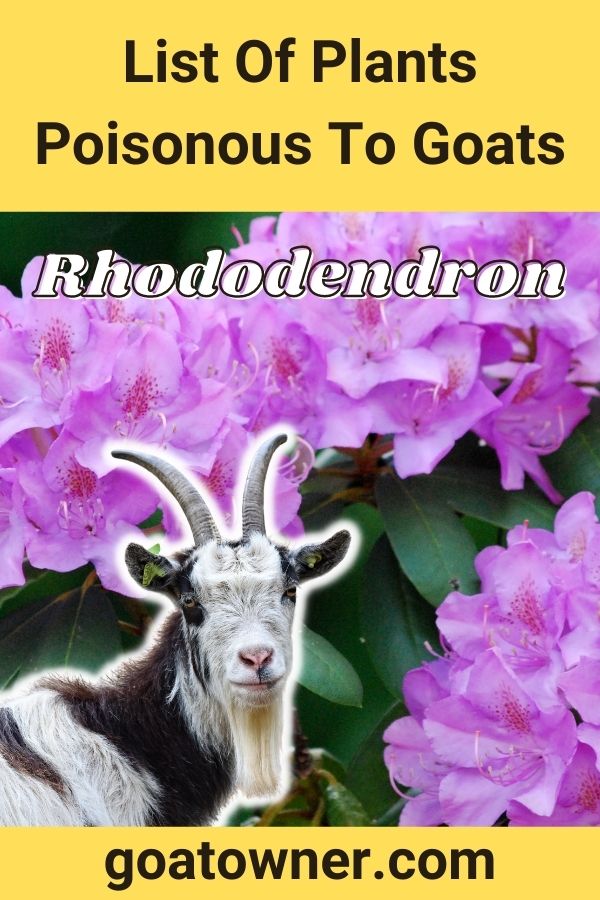
Rhododendron
Rhododendrons are one of the most popular garden flowers, and it’s easy to see why.
Their flowers are beautiful and colorful, emerging from already stunning bushes.
Rhododendrons can also grow just about anywhere with a mild climate.
They are one of the most common causes of poisoning in goats.
This is in part because goats find the flowers so attractive, as they do love to eat the flowers of many species.
Thus, goats are drawn to the plant and gorge themselves.
In the worst case, rhododendron poisoning could cause death.
If you want to grow rhododendrons, it has to be somewhere your goats will never get access to them.
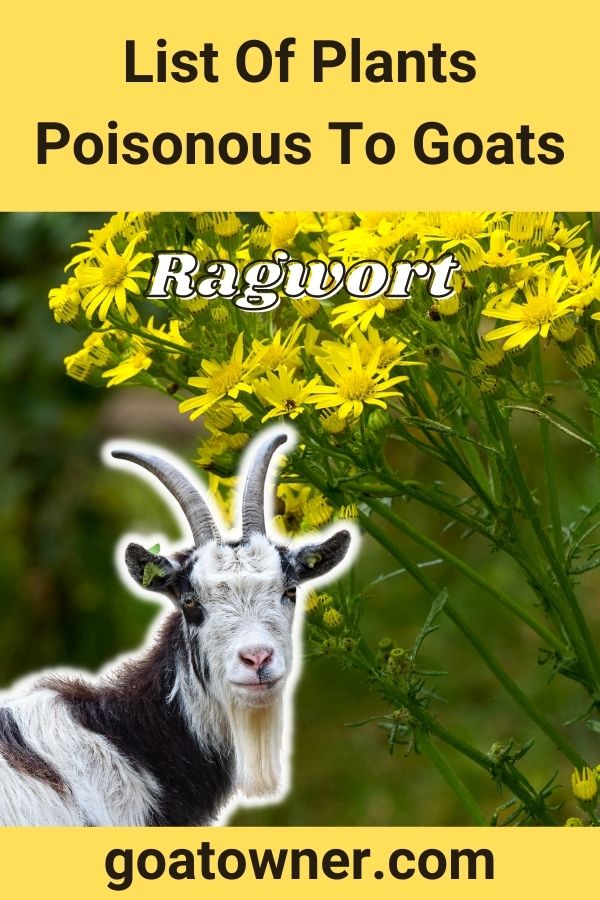
Ragwort
Ragwort isn’t widely cultivated—it is considered a weed.
But this just makes it all the more dangerous.
It will grow without you realizing it’s there, and your goats will be attracted to its bright yellow flowers.
It’s an extremely common wildflower found throughout the world, and can be difficult to get rid of.
It’s considered poisonous to pretty much anything that eats it.
Goats are no exception, and stand a chance of fatal injury from eating ragwort.
While you can take the chance that they’ll know to avoid it with many plants, I wouldn’t advise this for ragwort.
Keep an eye out for weeds like this.
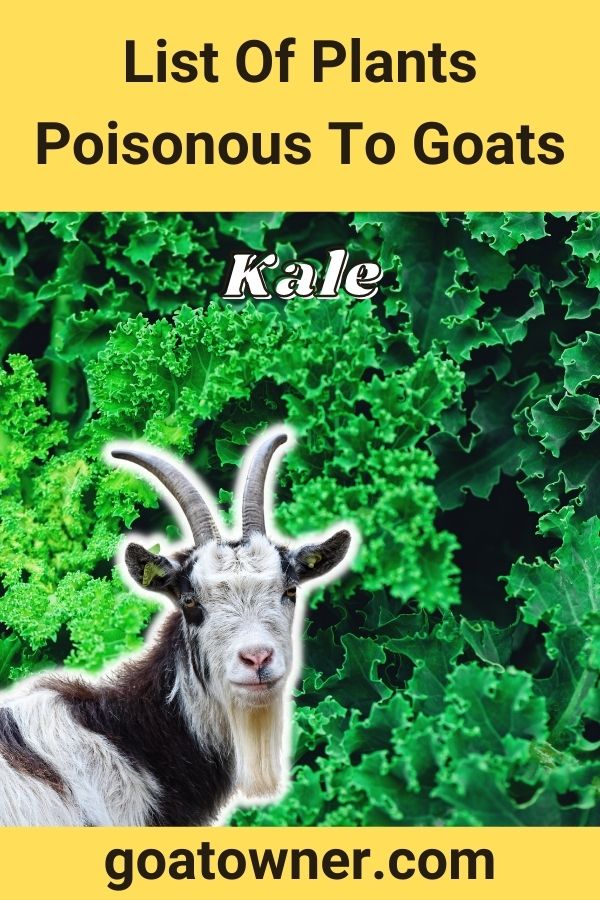
Kale
Kale is the rising star of gourmet and whole-food restaurants.
If you have the taste for it, kale is a fantastic, crunchy, tasty leaf to add to salads and other foods like burgers.
For many others, it is a nasty, tasteless leafy green.
To goats, however, there’s no room for individual taste.
It’s deadly poisonous due to the high amounts of oxalic acid in the plant.
Many similar leafy greens are way too high in oxalic acid to be safe for goats, and kale is one of the worst offenders.
Never let your goats eat kale.
Again, it probably won’t kill them, but it can do lasting damage.
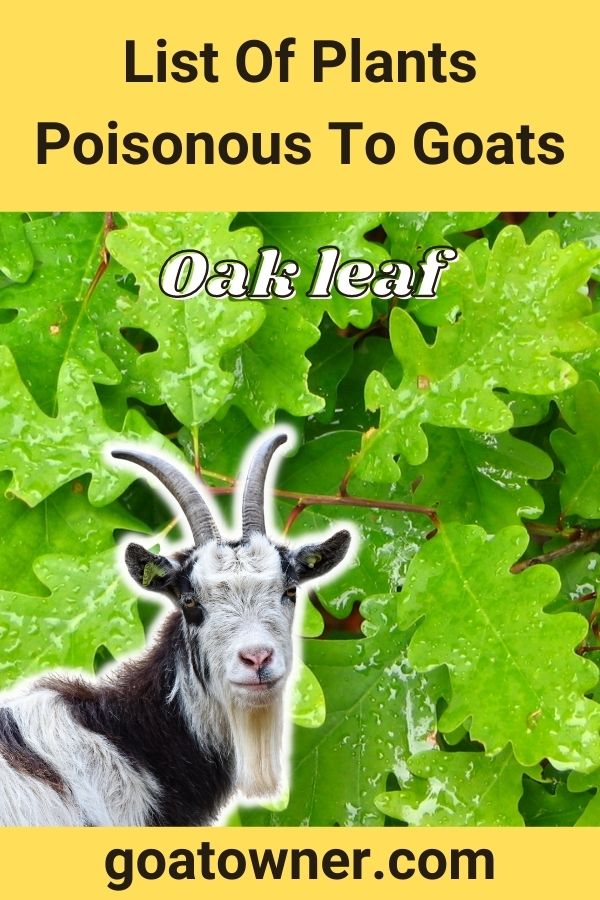
Oak leaf
Oak trees are one of the favorite staples of homesteads throughout the United States.
They’re really beautiful and impressive and have been a part of our collective mythos for centuries.
However, they do pose a poisoning threat.
To a number of different livestock species, goats included, many parts of the oak tree are poisonous.
The leaves in particular pose a big problem due to the high quantity of tannins in oak trees.
Tannins cause oak poisoning in goats, and other animals like horses.
Oak trees are one that goats generally seem competent to avoid on their own, but you should still keep this in mind.
They’re also generally quite harmless unless eaten in large quantities over a long period of time.
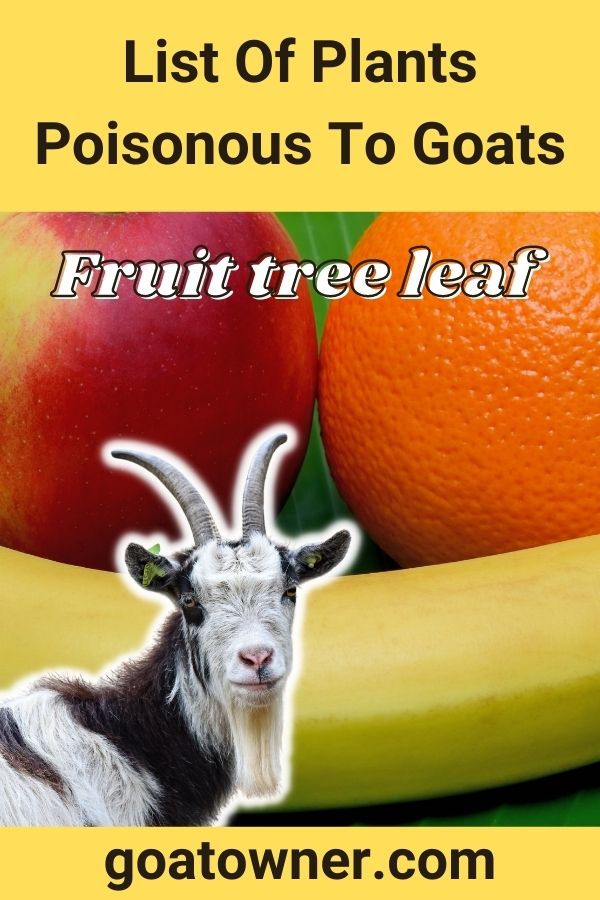
Fruit tree leaf
This is quite a broad classification, but that’s the point.
For this one, there is a whole family of fruiting trees of which the leaves are poisonous to goats.
This is one of the most common causes of poisoning in goats, as it includes a wide range of trees.
The leaves of more or less any tree in the Prunus family contain Amygdalin, which is a compound toxic to goats.
The fresh leaves are not much of a problem—it is when they dry up and the compound changes, now able to bind to red blood cells and prevent the movement of oxygen.
Try to rake these leaves away when they fall.
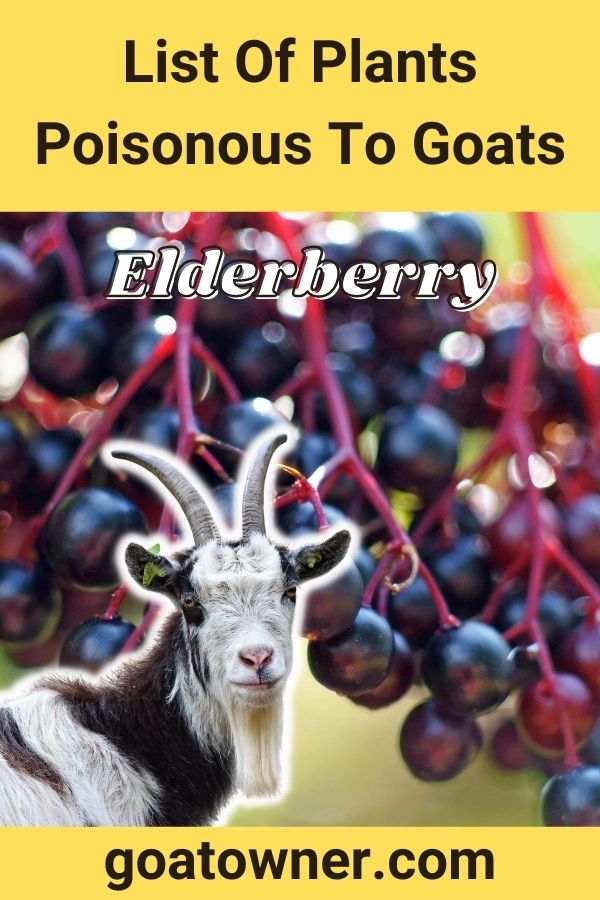
Elderberry
Most folks, including goats, look at the way elderberries grow on the plant and generally have the instinct that they’re at the very least not great, and could be poisonous.
And you would be right to have this instinct—but it goes further than that.
Pretty much every part of the elderberry plant, the berries, stems, leaves, and even the roots, contain a glycoside that induces cyanide poisoning.
Again, it typically isn’t enough to kill a goat unless they eat quite a lot of it, and elderberries, as I say, do really broadcast their inedibility.
Best not to take the risk, though.

Buckeye
Buckeye trees are another common variety found in many goat-rearing parts of the world.
These big, impressive, leafy trees can grow many feet high, and they’re another very typical sight on homesteads across the country.
As you may have been warned against it yourself at a young age, though, eating any part of a buckeye plant is very dangerous.
The danger for goats is typically eating the seasonal nuts that fall to the ground.
These are just as poisonous as any part of the plant, and can induce vomiting, diarrhea, and overall severe discomfort.
Be careful to clear up around the buckeye tree if you have one.
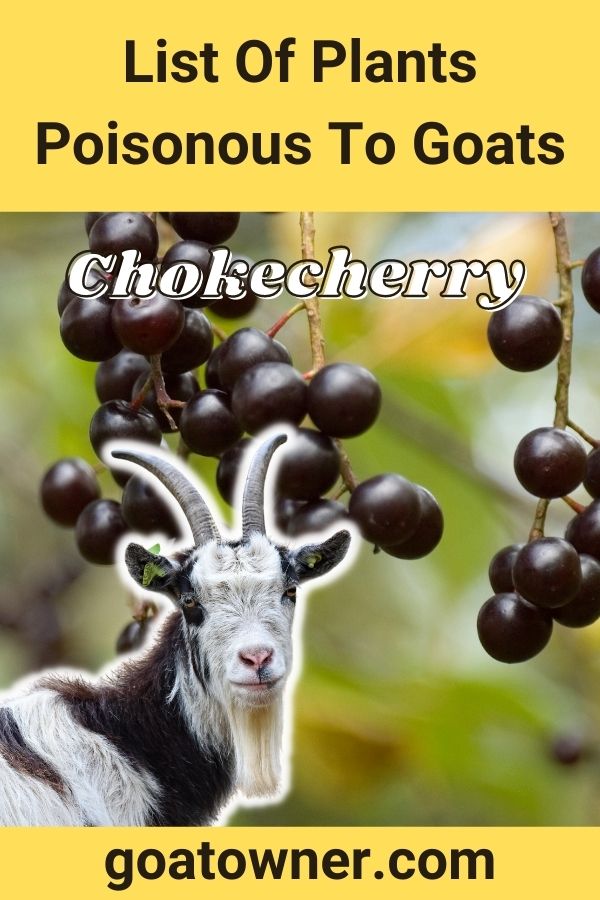
Chokecherry
Another cyanide containing plant, chokecherry is particularly deadly to goats if it eats too much.
Though when we think of cyanide we tend to think of almost instant death, this is only in the concentrated amounts that it would be used in capsules.
That doesn’t mean it isn’t dangerous, though.
The cyanide in a chokecherry could be deadly to a goat.
Again, though, chokecherry does broadcast the fact that it is inedible for goats.
What will usually happen is they try a small amount once and never touch it again.
Goats are smart like that.
But you still need to be very careful and monitor them.
Boxwood
Boxwood bushes are often a horticulturalist’s dream.
They’re quite easy to shape and work with once you get them growing, and they can give your garden a really polished look.
Alas, for the goat keepers of the world, they pose considerable danger.
Boxwood is poisonous not just to goats but to many animals including ourselves.
Like many others it would take a large quantity to be seriously harmful or deadly, but even a small amount can cause dizziness and vomiting.
Boxwood is more dangerous in a way because it looks quite unassuming.
It is in fact very dangerous.
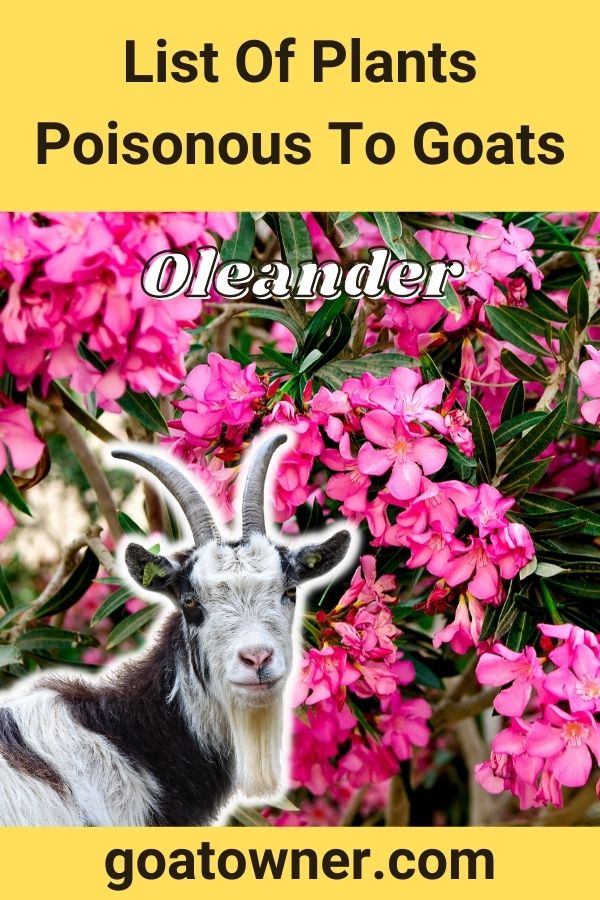
Oleander
Another popular exotic flower to grow in a landscaper’s paradise, oleanders are prized for their bright pink flowers and unfolding blooms.
Another rather unassuming little plant, but it’s actually one of the most poisonous and deadly that we’ve looked at so far.
For humans, a single leaf can be enough to kill a full-grown adult.
There are other varieties of the flower, and the red flower variety is considered the most toxic.
For goats, they are just as poisonous, and should really be completely avoided.
If they can kill a human, they can kill a goat.
Don’t grow oleanders anywhere near your goats.
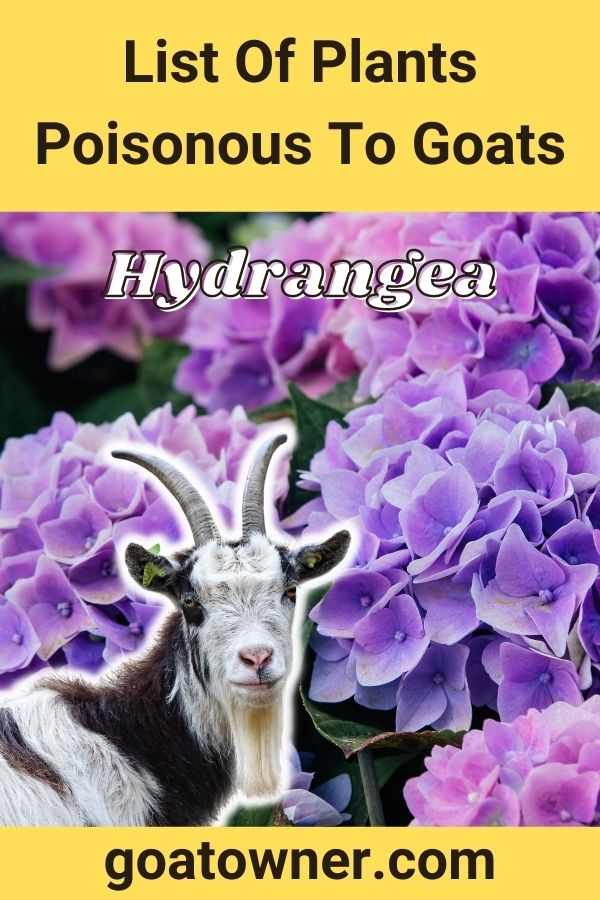
Hydrangea
Hydrangeas are another of the most common and popularly cultivated bushes in many parts of the world, and the wild varieties are quite different.
Both, however, are poisonous.
Hydrangeas are yet another plant containing toxic quantities of cyanide, and do need to be consumed in fairly large quantities to do serious damage.
Look for signs such as vomiting, diarrhea, and a general lack of interest in things.
Hydrangeas are a common problem for goats because they are so widely cultivated, so don’t take any chances with this.
They are potentially deadly.
Whether wild or cultivated, they contain pretty much the same quantity of cyanide.
Wild black cherry
Another berry that, if it doesn’t immediately and instinctively look poisonous, certainly doesn’t look very edible, either.
These are another that are especially dangerous, though, as they can and very often are fatal to virtually anything that eats them, particularly herbivorous mammals.
All parts of the black cherry plant are poisonous—the lives, the twigs, the seeds, and of course the fruit itself.
Do not allow your goat to eat any part of a black cherry plant.
This can cause death quite quickly, leading to spasms, gasping, weakness, and eventually respiratory failure.
Black cherries really are no joke, so do not take any chances with these nasty little plants.
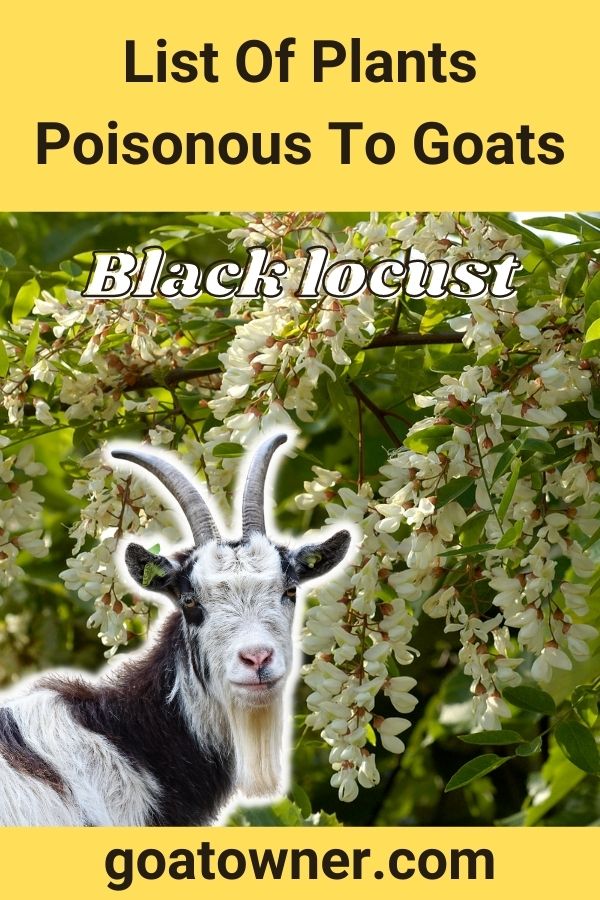
Black locust
To look at a black locust, if you have even a little knowledge of botany, you can probably have a good suspicion that it is poisonous.
It is arranged in such a way as to broadcast this, and put animals off eating it.
And, indeed, this is because it is extremely poisonous, to us, to cattle, and indeed to goats.
Any part of the tree is poisonous, the leaves, the flowers, the bark, the shoots—all of it, and all of it potentially fatal.
You could very easily die from ingesting this plant, and so could your goat.
It will cause kidney failure nausea, and if untreated, death.
Black locusts are very, very dangerous.
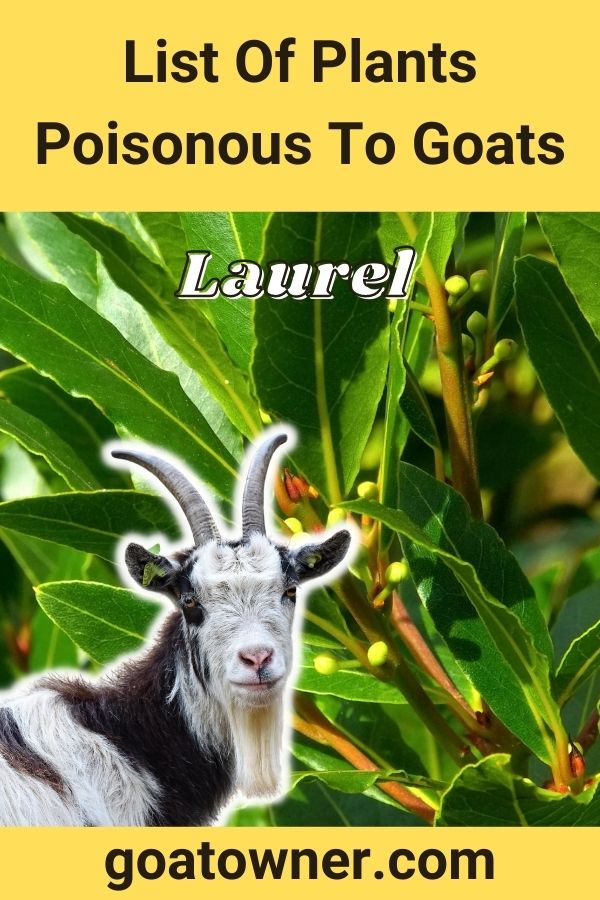
Laurel
Laurel does include a number of varieties, but you can rest assured there’s a simple way to tell which ones are poisonous: they all are!
Bay Laurel is the one exception, and even that one I wouldn’t particularly trust.
The problem with laurel bushes is they produce a compound called hydrocyanic acid.
If you’ve been paying attention, you’ll probably guess that this is essentially another form of cyanide.
Laurel trees all produce this acid, and it can cause very serious complications if you ingest it.
In large enough quantities in your goat, it could very easily kill them.
Make sure to remove laurel trees from your pasture.
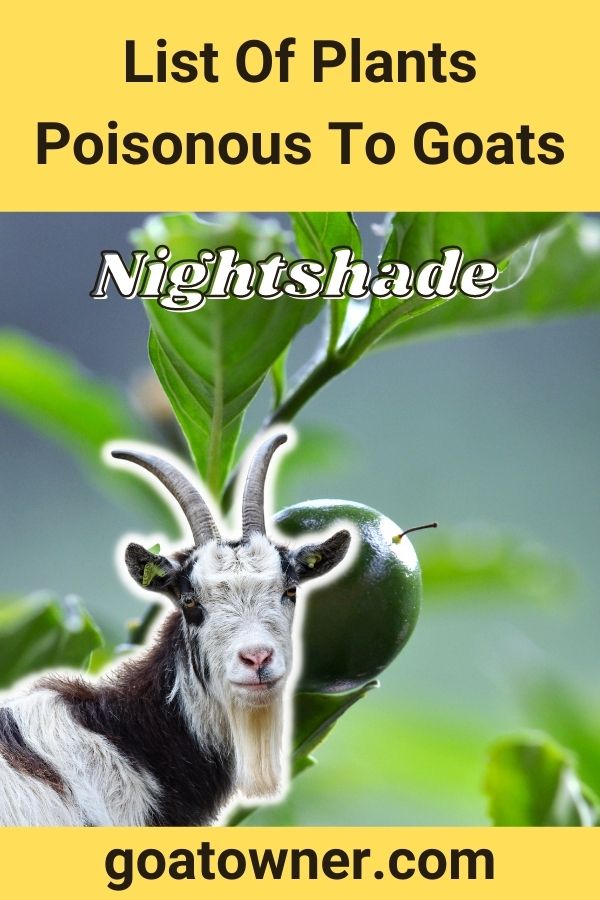
Nightshade
Nightshade is another of the most common causes of poisoning in goats, as it encompasses a lot of vegetables that many might not think twice about giving to their goats.
The nightshade family includes things like tomatoes, eggplant, peppers, potatoes, and many other things.
All of them are poisonous to goats.
While they aren’t likely to kill your goat except in larger quantities than your goat would ever eat, they are still extremely dangerous and should be completely avoided.
Nightshades contain small amounts of alkaloids that are toxic to goats.
So, don’t let your goats have any kind of nightshade plant, and be sure to look up exactly what all of these are.
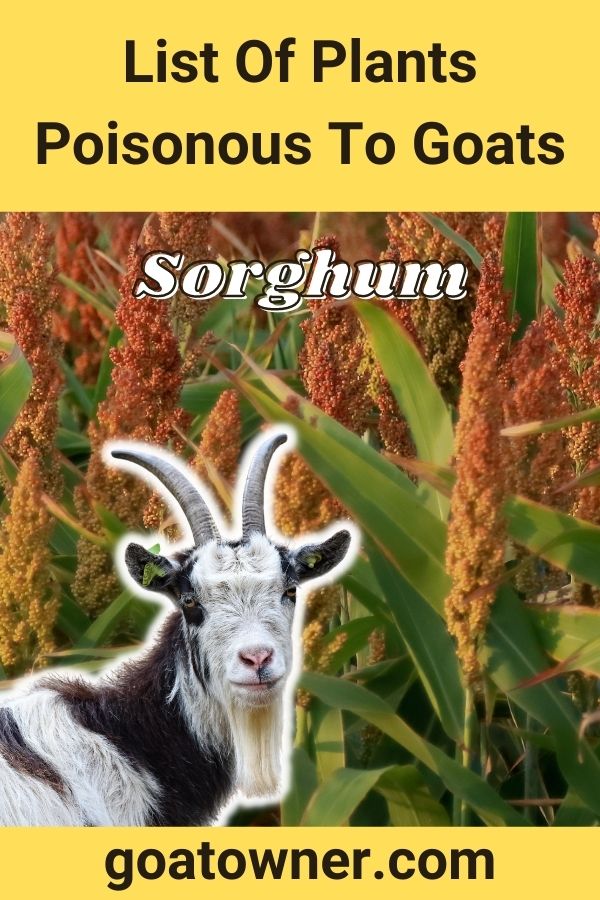
Sorghum
Sorghum is another one that you might be surprised to see on this list, since it is a common grain feed for many livestock animals.
It’s commonly used by farmers to provide quality diets to a variety of livestock.
For goats, however, it’s no good.
Especially if it is not stored correctly.
In very hot and dry conditions, the stress caused to these plants makes them accumulate toxins, exacerbating the problem even further.
Sorghum might have some advantages as grain or forage feed, but there are plenty of much safer alternatives that you don’t have to worry about harming your goat.
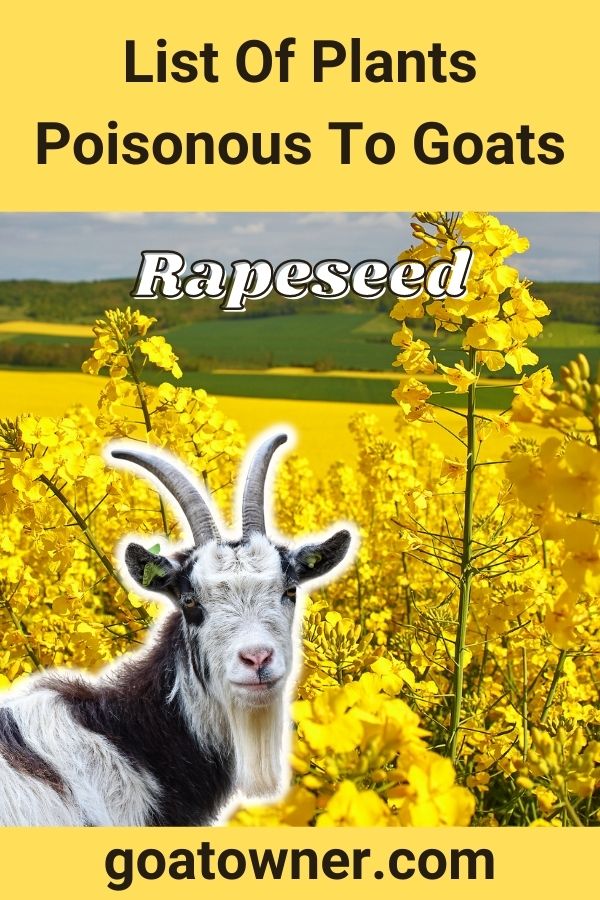
Rapeseed
Another common weed found in many parts of the world, rapeseed is instantly recognizable in its long, towering yellow flowers covering fields.
It’s a seriously invasive plant and can be a real problem for homesteads when it isn’t kept in check.
Toxic to many animals, goats included. Rapeseed can cause anemia, blindness, nerve damage, digestive disorders, and even respiratory issues.
Rapeseed is no joke and even if it were not to kill your goat, it could do them massive amounts of lasting harm.
Again, unassuming as rapeseed might look, even attractive as it might look to a goat who didn’t know better, it’s very dangerous, and should be removed.

Velvet grass
Found mostly in sterile, sandy, moist and open fields and meadows, velvet grass is not the most common weed around, but it is nonetheless a danger you should be aware of.
It is indeed considered an invasive species in many places, including outside its native range.
When the plant is not fully dry, it can be poisonous to many species of livestock.
When dried out it isn’t so much of a danger, but given that it is invasive, you should not take this risk.
The problem with velvet grass is often the very fact that it is not as widely recognized.
This makes it particularly dangerous since goat owners may allow it to run wild on their pasture, not realizing it is potentially deadly.
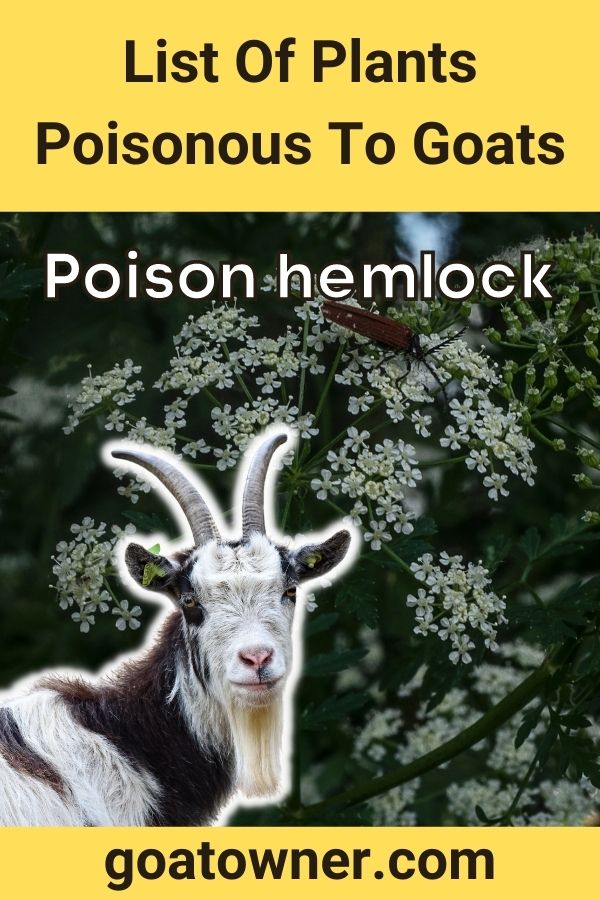
Poison hemlock
This one kind of gives itself away with its name.
Poison hemlock is a very dangerous and very poisonous plant that occurs in Europe and North Africa.
They are just as poisonous to goats as they are to us, so you should not take any chances with hemlock.
Get rid of it the moment you see it.
They are easy to identify by their white flowers and long, branching stalks.
Any part of the plant is potentially deadly, and they can become somewhat invasive in the correct conditions.
So, if you were under any confusion about the name, poison hemlock is very poisonous and you should not allow your goats to get near it.
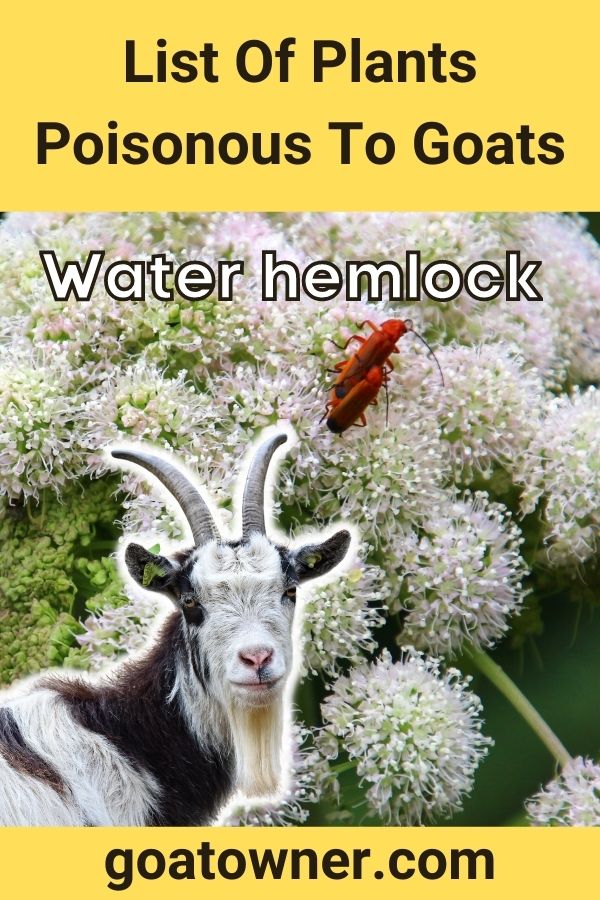
Water hemlock
Staying with the hemlock family, the closely related water hemlock.
Even though it doesn’t state right in its common name that it is poisonous, water hemlock is just as poisonous as poison hemlock.
This plant is toxic at any and all stages of its development, and can even be absorbed through the skin.
Ingestion of water hemlock in goats can cause nausea, pain, and digestive distress.
Another one that would take quite a large amount to be fatal, but not so much that you needn’t worry about it.
The most dangerous part of the plant is the tuberous roots, which goats are actually quite fond of in some plants.
Don’t let your goats near water hemlock.
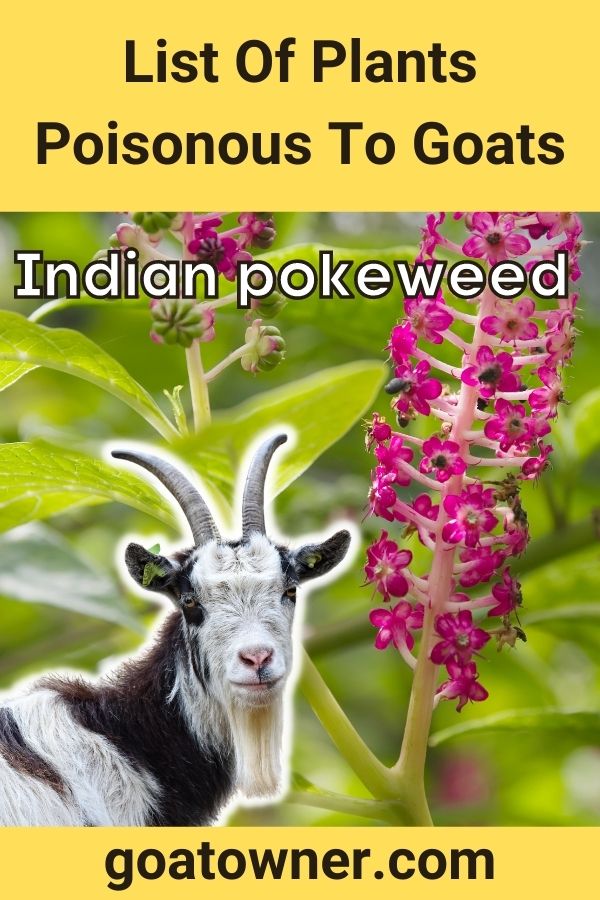
Indian pokeweed
A somewhat more exotic weed, but a weed nonetheless, Indian pokeweed is a highly problematic and toxic plant that can easily kill a goat in large enough quantities.
Like with hemlock, it is the roots that are the most poisonous part of the whole plant.
But the leaves, the stems, the seed—the whole of the plant is toxic to goats and should not be fed to them.
This is yet another invasive weed, and despite the name it can grow in a wide variety of climates.
Indian pokeweed should be identified and removed at the earliest possible stage.
It can cause respiratory and digestive distress.
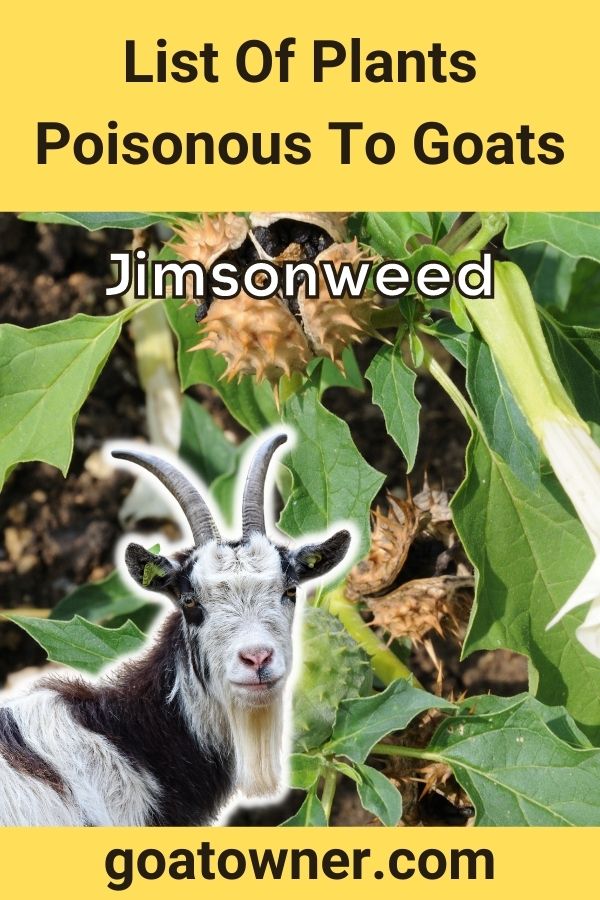
Jimsonweed
Jimsonweed, or Datura, has been a popular plant in folk medicine in many cultures throughout the world.
It has been used in rituals and in all sorts of healing processes, and there even is some good data that suggests it can work in certain circumstances.
However, it is deadly toxic when unprepared.
It is even psychoactive, meaning that it can cause hallucinations—both in your and in your goats.
It will also cause thirst, vision impairment, vomiting, it will increase your goat’s heart rate and temperature—a whole host of potential issues.
Jimsonweed is much less common than a lot of the plants we’ve discussed so far, but it is easily recognizable by its large, white flowers.
Don’t take chances, get rid of it.

Buckwheat
Buckwheat isn’t like any of the others we’ve mentioned so far.
It’s widely cultivated as a foodstuff, and when grown and prepared properly it can be very nutritious for humans.
However, for goats, it’s a very different story.
Buckwheat is highly poisonous to goats in basically any form, due to the presence of a compound called fagopyrin.
The only place you won’t find this compound in the plant is in the seeds once they are fully ripened.
Fagopyrin is absorbed into the bloodstream after the buckwheat is digested, and then reacts with sunlight to cause a wide variety of issues.
It’s dangerous and potentially deadly, so don’t let your goats eat buckwheat.

Rattleweed
An herbaceous perennial, rattleweed is likely familiar to many of us as the small, fern like plant that grows out of the ground in woodland areas.
With shallow, widely branched roots near the surface, they are exactly where goats would want them to eat.
The seeds in the pod break and rattle when dry—giving it its name.
The plant is highly poisonous to most wildlife and livestock, and goats are no exception.
Eating enough of it can be toxic, although they would admittedly have to eat a great deal to poison themselves.
It’s another one you will want to scan your pasture for, in any case.
If you see it, be sure to completely uproot it.
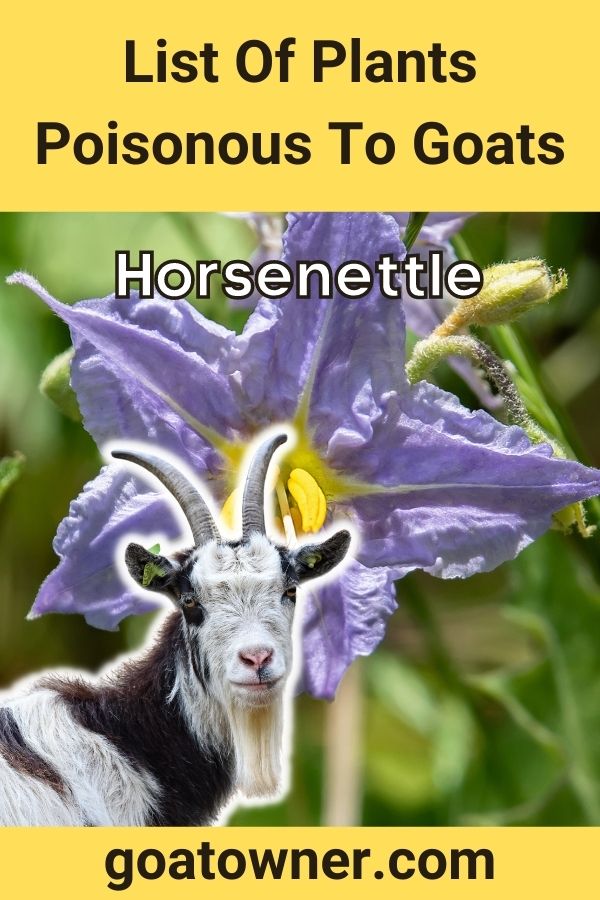
Horsenettle
Horsenettle is another rather unique looking plant, distinctive with its lilac flowers, its yellow fruit and characterized by hard, sharp spines on the stems.
If the spines themselves aren’t enough to keep your goats away, then the toxicity will be.
The problem with horsenettle is the presence of solanine in the plant.
Solanine is a highly toxic compound that is deadly to many animals like goats.
Indeed, the whole family of plants in this genus contains some degree of solanine.
All parts of the horsenettle plant are toxic and potentially deadly.
If you see horsenettle anywhere near your pasture, get rid of it to stop it from spreading.

Fumewort
Fumewort are another of those ones that are so attractive it can be easy to forget how potentially dangerous they are.
Gorgeous purple flowers jut out of leafy green bushes on long stalks, commonly cultivated for their attractive appearance.
They grow in shady places in Europe and Asia.
Fumewort plants, all parts, contain large quantities of alkaloids which are potentially deadly to goats.
Again, they would most likely have to eat a great deal to suffer serious ill effects, but it’s not worth the chance.

Black cohosh
Perhaps one of the most obscure plants on this list, black cohosh is, again, instantly recognizable once you know what you’re looking for.
Tall, white flowers protrude out of a sea of green, and on the tips of their flowers they produce small berries which are edible to some species.
To goats and livestock, though, they are dangerous and poisonous.
Particularly the berries are the most dangerous part, but the whole of the plant is poisonous.
Birds seem to be immune to the toxin, as they often are with things poisonous to us.

Wolfsbane
Wolfsbane, also known as monk’s hood, is another common plant that belongs to a wider family of toxic plants.
Indeed, in the United Kingdom, wolfsbane is one of the most toxic plants you can find.
The compounds present in wolfsbane can cause a severe slowing of the heart rate, which can eventually be fatal.
Even a very small amount can be problematic for goats, causing pain and nausea.
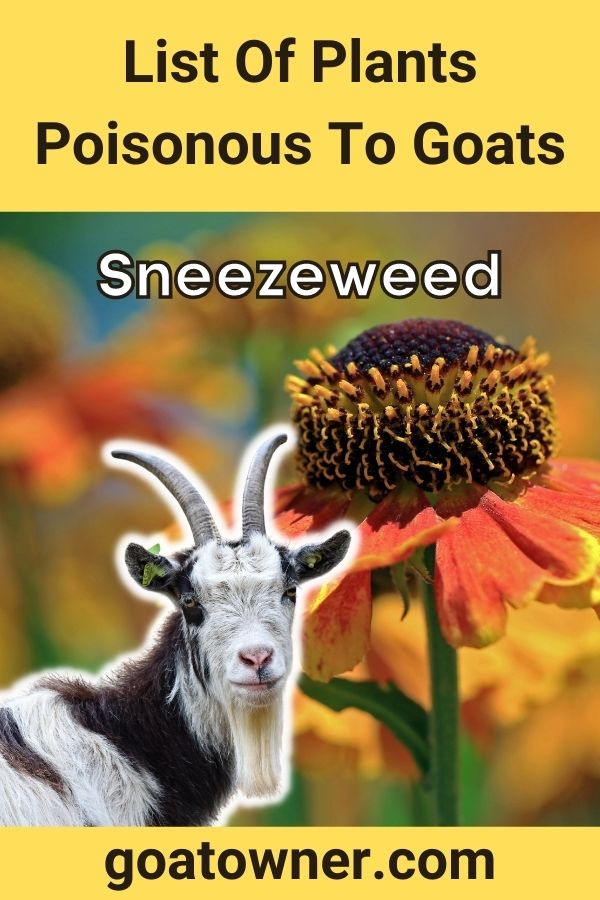
Sneezeweed
Sneezeweed is potentially the funniest name of any of the plants we’ve looked at, and you’ll be somewhat relieved to hear there is no confirmed reports that this plant is toxic to humans.
However, it is very dangerous for goats and many other household animals.
Enough sneezeweed could quite easily kill a goat, so you’ve got to be sure you remove it if you find it on your pasture.
Again, do not take any chances with sneezeweed.

St. John’s wort
Another wort for the list is St. John’s wort, recognizable by its striking yellow flowers and tall, green stalks.
Again, often this color palette makes them very attractive to goats, and the fact that they grow so rapidly.
However, this wort also contains a compound called hypericin.
This, when altered under digestive circumstances, causes damage to cell membranes of skin cells.
This can eventually lead to the complete death of areas of the skin.
It can also have an impact on oxygen movement in the body.
St. John’s wort is very dangerous for goats.
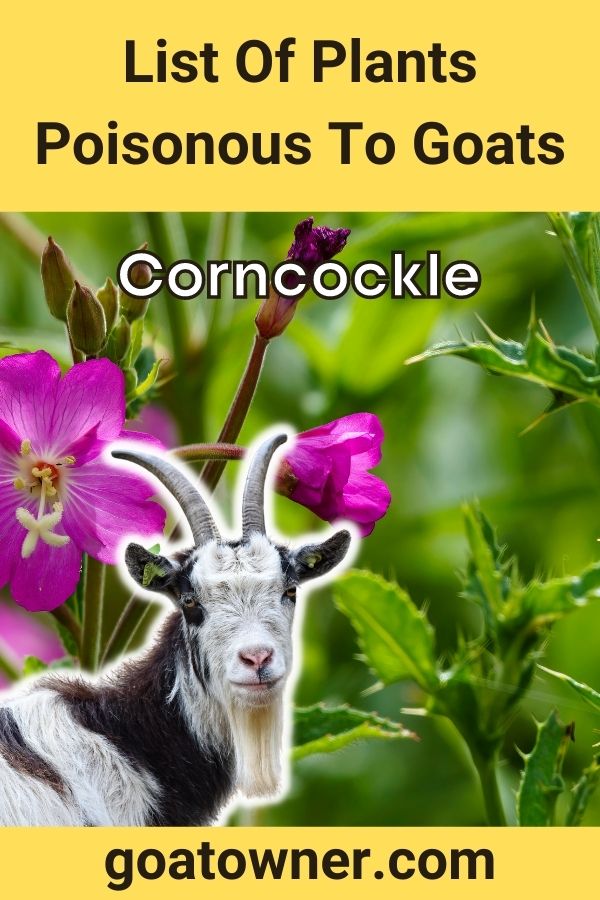
Corncockle
Yet another favorite of the landscapers out there, and it’s easy to see why.
Corncockle produces such a beautiful and rich color in its flowers that botanists would be crazy not to want them all over their garden.
For the goat owners among us, though, you should take pause.
Corncockle contains many noxious acids and toxins in only a small amount of the seeds. 3 grams is enough to kill a horse, so you can only imagine what it would do to a goat.
Do not let your goat near corncockle.
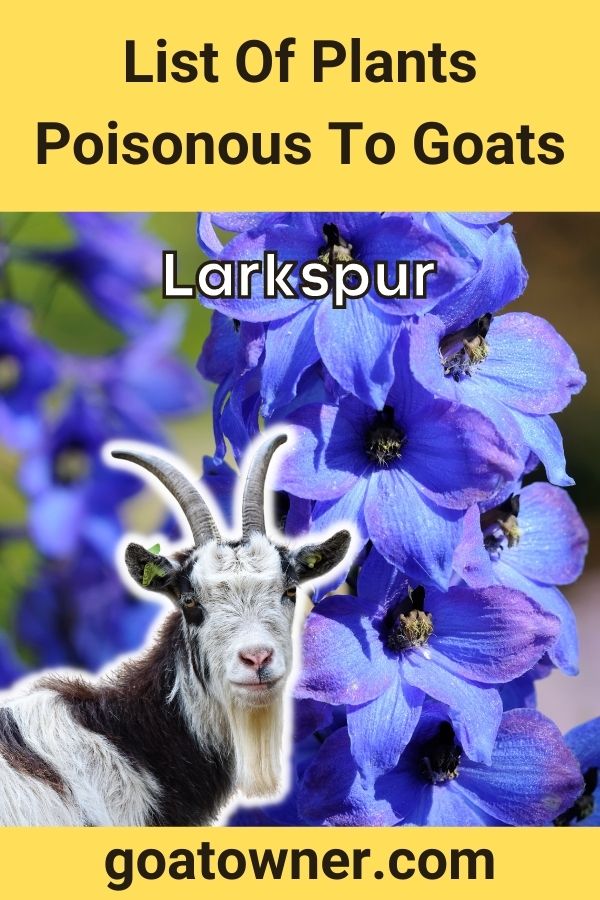
Larkspur
Staying with some of the most beautiful and precious but also toxic and deadly plants you might need to worry about, larkspur is a tall, vibrant blue or purple flower that grows tall out of grassy meadows.
When they are in the new growth stage, this is when the whole flower, but particularly the seeds, contain the highest concentration of toxins.
Again, goats may or may not be attracted to them, but your safest bet is to remove them where you find them if your goats can get to them.
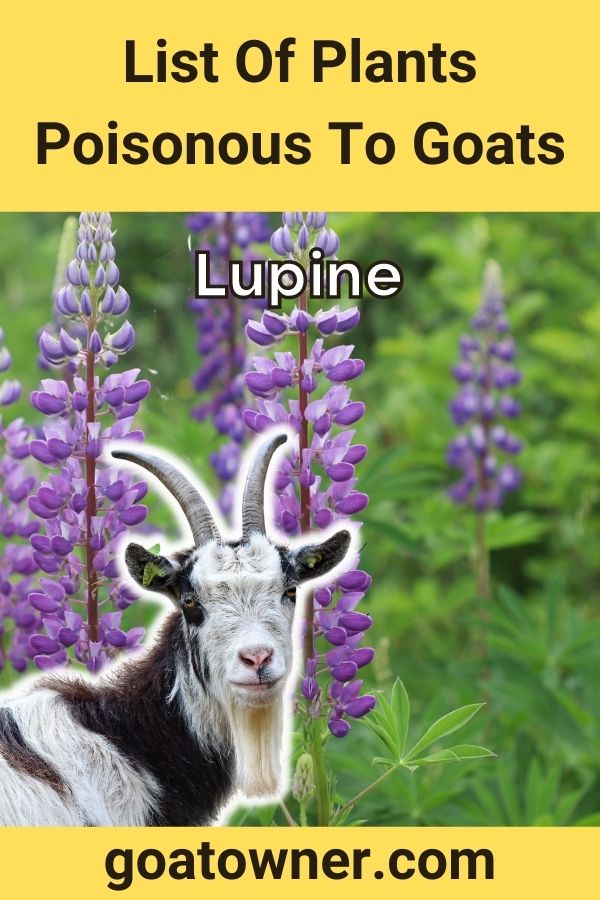
Lupine
There are quite a few varieties of lupine, distinguishable by color.
Characterized again by tall, stalky flowers out of green bushes, they are a common sight in meadows in Europe and Asia.
The flowers are not as poisonous as the rest of the plant in this flower, but it is the seeds that are the biggest problem.
Not all varieties are poisonous, but it can be difficult to distinguish them.
The toxin level isn’t always completely consistent, but again, it’s just better to be safe and assume they pose a big threat.
Keep an eye out for lupine growing in the early stages.
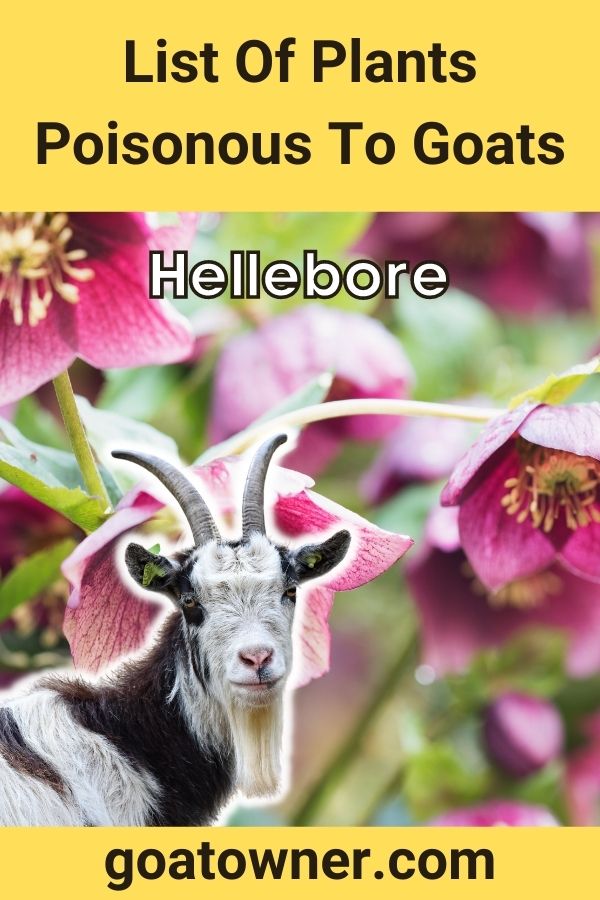
Hellebore
Another incredibly vibrant and beautiful flower, the hellebore is very commonly cultivated as an exotic addition to a flowerbed.
They have wide, round flowers with huge petals and attractive yellow centers.
Again, though, to both goats and to other livestock, all parts of the plant are poisonous.
They can be very deadly in large enough quantities, so do not take any chances with this.
Call a vet if your goat eats any hellebore.
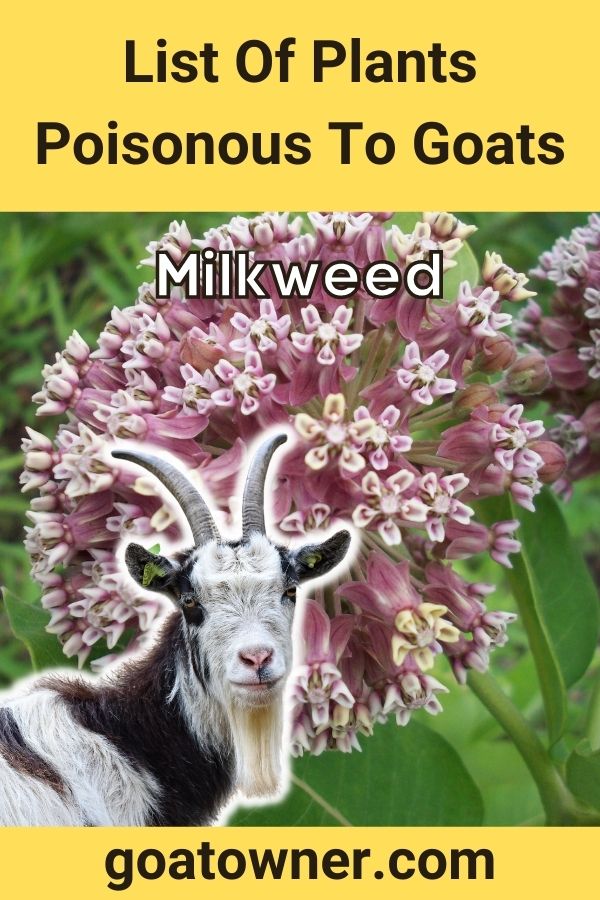
Milkweed
One of the entries on our list that you are more likely to look twice at before assuming it is safe, milkweed produces strange, tall stalks and bunched-up white and red flowers.
Again, there are several species of milkweed and not all are toxic to goats, but it is safe to assume that most are.
Most milkweed leaves or really any part of the plant above the ground contain glucosidic substances called cardenolides.
These are toxic to the point of deadly, so, again, don’t take any chances and make sure you remove any that you find.
This list contains many different common plants and it is still not an exhaustive list.
If you are new to keeping goats, then this list should show you that you might need to be a bit more careful about what they eat than you thought.
While, for the most part, most of these plants won’t produce a deadly reaction in one sitting, they’re perfectly capable of causing lasting damage.
You should always check your pasture for new growth, and move swiftly to identify things you can’t identify by sight.
Don’t take any chances.

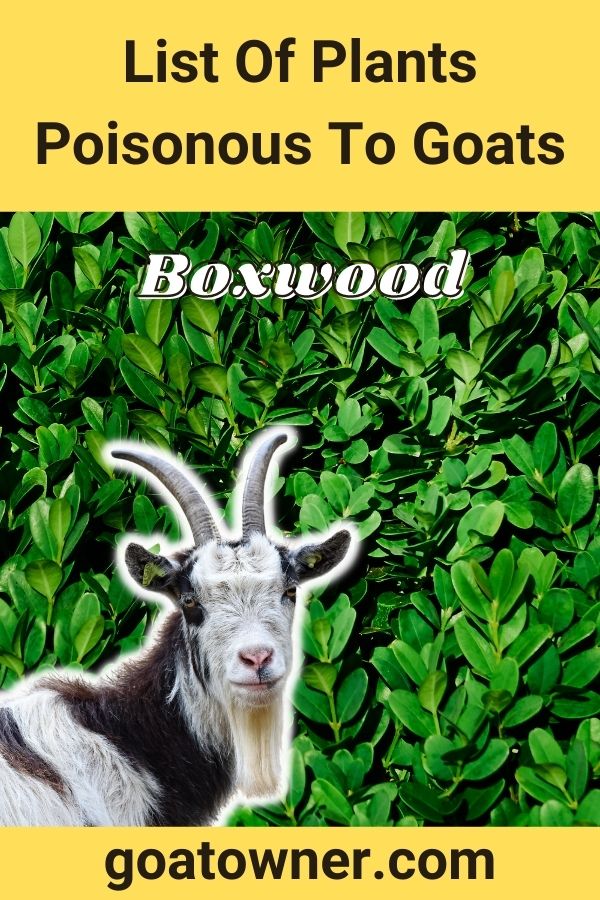
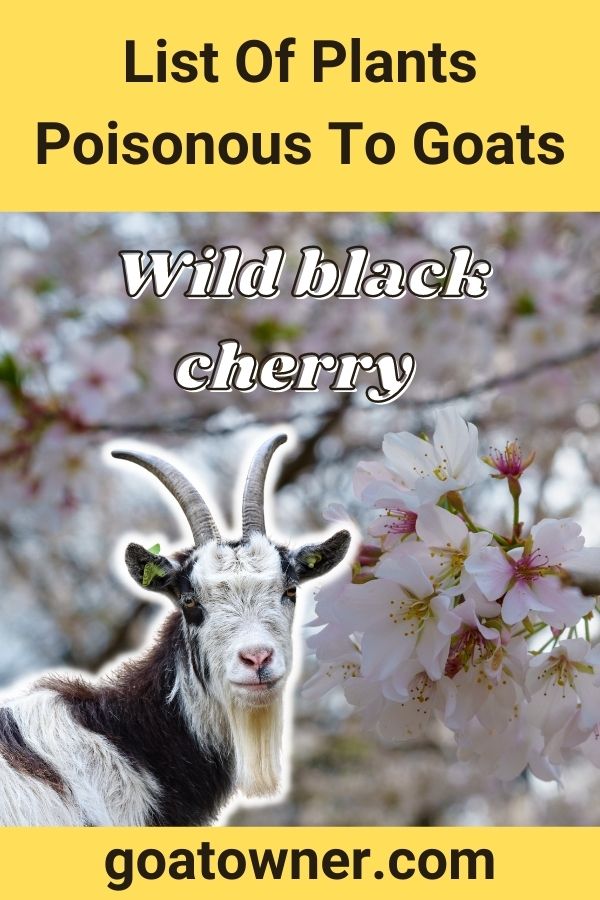
I had no idea, I knew some of those plants were poisonous to other animals but I didn’t realize goats were included. I guess even Superman can be poisoned though😁
what are the sources you are citing? also what are the botanical names of the plants — common names can be confusing.
I’m curious about this as well
The expository write up educating. It will help me to ward off goats from my flower garden.
Why is Flowering Spiraea not listed as poisonous? I have found that on other lists.
There is something peculiar with goats and some of these plants that are listed here. My goats eat oak- and fruit tree leaves almost every day in summer and spring. Sometimes a little and sometimes large branches.
It’s true that some plants can be deadly and dangerous, but what many goat owners know is that even grass can be deadly for goats, when they’ve been in a barn in the cold season and only have eaten grass and pellets. The whole point is that their gut bacteria have to adjust to strange food.
Free roaming goats and wild goats know instinctly what they can eat, what they can’t eat and when they only should eat a little to give their digestive system (gut bacteria) the time to adjust.